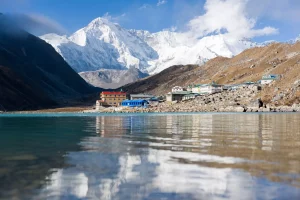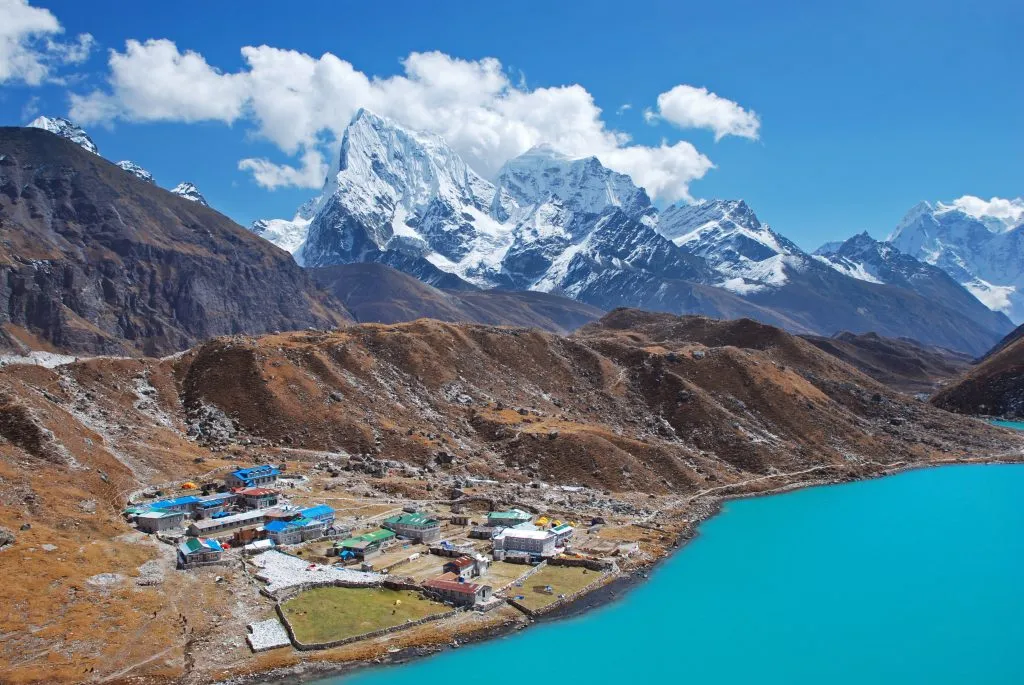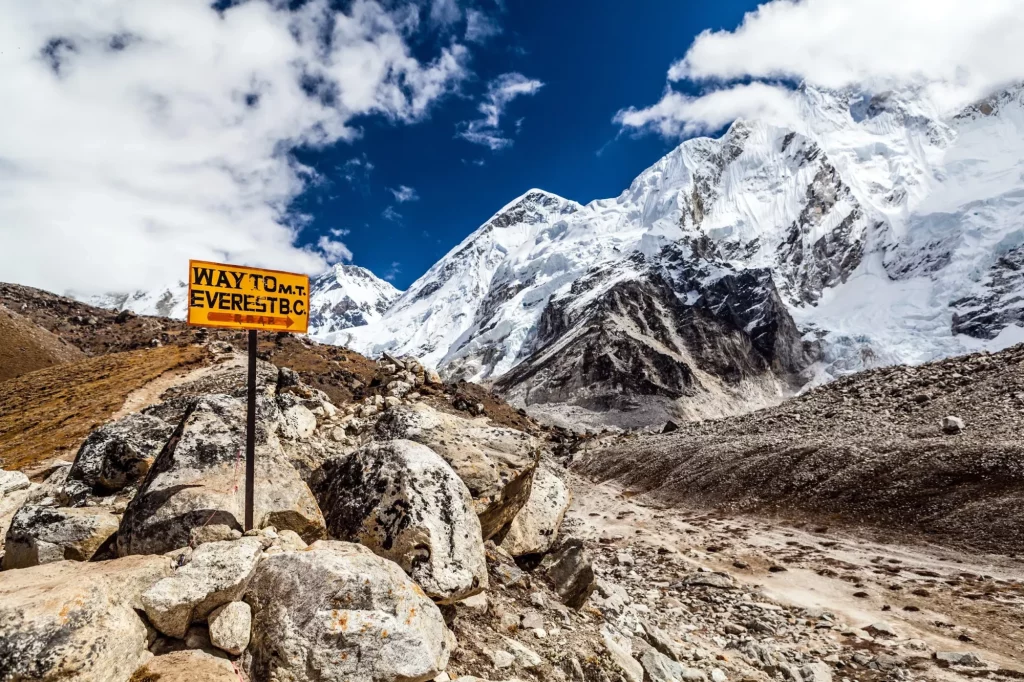
Gokyo Lakes Trek
Explore the serene turquoise Gokyo Lakes, the highest freshwater lake system in the world
Ascend Gokyo Ri for panoramic views of the entire Everest region
Trek to the iconic Everest Base Camp, witnessing the world of mountaineering
Traverse the Ngozumpa Glacier, the largest glacier in the Himalayas
Experience the vibrant Sherpa culture in villages like Namche Bazaar
Cross the challenging high mountain pass of Cho La
Itinerary
Arrive in Kathmandu, the capital city of Nepal. Our representative will receive you at the airport and transfer you to your selected hotel. After settling in, meet your guide for a briefing and review your equipment. Spend the evening exploring the local markets or resting up for the adventure ahead.

Take an early morning flight to Lukla, the gateway to the Everest region. Begin your trek to Phakding, passing through the beautiful Sherpa village of Chheplung. Enjoy the surroundings and the view of Mt. Khumbila as you rest in Phakding.

Trek along the Dudh Koshi River, crossing several suspension bridges, to reach Namche Bazaar. The trail offers the first glimpse of Mt. Everest and other peaks. Spend the evening exploring the local market or relaxing in this vibrant town.

Acclimatize to the high altitude with a short hike to the Everest View Hotel, offering panoramic views of Mt. Everest and other peaks. Explore the Sherpa Culture Museum and the local market in Namche Bazaar.

Trek to Phortse Thanga, passing through rhododendron forests and enjoying views of Thamserku and Khumbila mountains. The village offers a peaceful retreat with opportunities to observe local Sherpa culture.


Continue through forests and small settlements to Machhermo. The beautiful valley provides a serene setting to unwind, with views of Cho Oyu and other peaks.

Ascend to Gokyo, a picturesque village by Gokyo Lake. Enjoy the stunning views of the surrounding mountains, including Cho Oyu, and explore the series of Gokyo Lakes.

Hike to Gokyo Ri for breathtaking panoramic views of the Everest region, including Mt. Everest, Makalu, and Cho Oyu. Return to Gokyo and spend the rest of the day at leisure.


Trek to Thagnak, crossing the Ngozumpa Glacier, the largest glacier in the Himalayas. Enjoy the serene mountain views and the unique glacial landscape.


Cross the challenging Cho La pass to reach Dzongla. The pass offers stunning views of the surrounding peaks, and Dzongla provides a comfortable haven after a demanding day.


Trek to Lobuche, a small settlement at the base of Lobuche peak. The trail takes you through alpine meadows and past memorials dedicated to climbers who have lost their lives on Everest. As you ascend, enjoy views of Ama Dablam, Pumori, and other majestic mountains. Upon reaching Lobuche, take in the stunning views and unique high-altitude landscape as you prepare for the next day’s adventure.


Embark on the highlight of the trek as you make your way to Everest Base Camp. Traverse the rocky dunes, moraines, and streams of the Khumbu Glacier. Witness the stunning icefall flowing from the Western Cwm, and finally, reach the base camp, a bustling hub for climbers. Soak in the achievement before descending to Gorak Shep, a small settlement that offers a cozy spot to reflect on the day’s achievements and rest.


Start early to hike to Kala Patthar, known for its breathtaking sunrise views over Mt. Everest. The panoramic vistas of the Everest massif are unparalleled. After capturing memories, descend to Pheriche, a scenic village known for its picturesque setting. Pheriche also hosts a Himalayan Rescue Association Aid Post, providing insights into high-altitude medicine.

Retrace your steps back to Namche Bazaar, descending through beautiful forests filled with rhododendrons and juniper trees. The trail offers a different perspective as you leave the high mountains behind. Enjoy the comforts and lively atmosphere of Namche Bazaar, perhaps visiting local markets or cafes.

Continue your descent, trekking back to Lukla. Absorb the final sights and sounds of the Everest region, passing through Sherpa villages and crossing suspension bridges. Lukla marks the conclusion of your time on the trail, offering a chance to celebrate with your team and reflect on the incredible journey.

Take an early morning flight back to Kathmandu. The scenic flight offers one last view of the towering Himalayan peaks. Upon arrival in Kathmandu, transfer to your hotel and enjoy the rest of the day at leisure. Explore the city’s cultural sites, indulge in some shopping, or simply relax and savor the memories of your trek.

Depart from Kathmandu, taking with you the unforgettable memories of the Gokyo Lakes to Everest Base Camp Trek.

Pricing
Included in price
Accommodation on a BB basis in Kathmandu in a three-star hotel in twin/double sharing
Accommodation in Tea House/Lodge during trekking
Ground transportation as per the itinerary
Flight fare for Kathmandu-Lukla-Kathmandu
Three meals while trekking
A government-licensed English-speaking guide
A porter (one porter for two people, carrying up to 20 kg)
All necessary paperwork like permits and TIMS card (Trekkers Information Management System)
Sagarmatha National Park entrance fees
Salary, food, drinks, accommodation, transportation, and insurance for the guide and porter
Travel and rescue arrangements
All our government taxes, official expenses, and service charges
24/7 call assistance from our office representative
Achievement certificate
Meals in Kathmandu
Nepal Visa
International Flight Ticket
Any type of insurance
Personal nature expenses like bar bills, hot water, drinking water, tea/coffee, shower, laundry, Wi-Fi, and charging in the trekking route
Tips for Guide and porter
Any extra cost that is not mentioned in the Cost Includes column
Extra day for natural calamities like floods, landslides, and flight cancellations
Government taxes and office service charge
Description
The Gokyo Lakes to Everest Base Camp Trek, also known as the Everest Base Camp Trek via Gokyo Lake, is a popular and challenging trekking route located in the Khumbu region of Nepal.
This unique adventure combines the stunning beauty of the Gokyo Lakes with the iconic Everest Base Camp, providing trekkers with a breathtaking experience in the heart of the Himalayas.
Your journey begins with a scenic flight from Kathmandu to Lukla, a small mountain airstrip. From Lukla, trekkers start their ascent through the picturesque villages of Phakding and Namche Bazaar, the gateway to the Everest region. Namche Bazaar is a vibrant town and serves as the acclimatization point for trekkers to adjust to the high altitude.
The Gokyo Valley is renowned for its serene turquoise lakes, including the main Gokyo Lake, which is the highest freshwater lake system in the world. The Gokyo Lake Trek leads trekkers to explore the series of lakes and enjoy the pristine beauty of the surrounding landscape.
The nearby Gokyo Ri Trek offers a stunning panoramic view of the entire Everest region, making it a must-visit destination for trekkers.
Reaching Everest Base Camp is a significant achievement for many trekkers, as it offers a glimpse into the world of mountaineering and the climbers’ preparations for their Everest summit attempts. The base camp itself is a sprawling tented village, set against the backdrop of towering Himalayan peaks.
The Gokyo Lakes to Everest Base Camp Trek is a challenging adventure that requires a good level of physical fitness and acclimatization to the high altitude.
Overall, it offers a unique blend of natural beauty, cultural encounters, and a sense of accomplishment, making it an unforgettable experience for adventure enthusiasts from around the world.
How Can I Prepare for the Gokyo Lakes to EBC Trek?
The Gokyo Lakes to Everest Base Camp Trek demands proper preparation and the right equipment. From sturdy hiking boots to warm clothing, selecting the right gear is essential for a safe and comfortable journey.
Trekkers must also consider the high-altitude environment and prepare for potential challenges such as altitude sickness. Many opt for pre-trek training to build stamina and endurance. Additionally, experienced guides and porters play a vital role in ensuring a successful trek, providing expert navigation, support, and local insights.
This combination of preparation, equipment, and expert guidance creates a rewarding trekking experience that caters to both novice and seasoned adventurers.
To get a detailed insight into how to prepare for the trek, check out our comprehensive guide.
Why Should I Have a Guided Tour in the Gokyo Lakes Region
As of April 1, 2023, the Nepalese Tourism Board has advised that all trekkers in Nepal must be accompanied by a guide, making it mandatory for the Gokyo Lakes trek.
The Gokyo Lakes region is known for its challenging access and extreme climates, and having a professional guide ensures safety, security, and expert navigation. Guides offer valuable insights into potential hazards, local culture, and the best viewpoints. They also manage accommodation and logistics, provide emergency support, and facilitate meaningful interactions with the local community.
The law was implemented to ensure trekkers’ safety, as many have gone missing or faced mishaps on the way.
Choosing a guided trek with our experienced team not only aligns with legal requirements but also enhances the overall trekking experience, providing peace of mind and supporting the local population.
Things to know
Several international airlines operate flights to Kathmandu, Nepal. These include Malaysian Air, Qatar Airways, Fly Dubai, Air Arabia, Turkish Airlines, Thai Lion Air, and some Indian airlines like Air India and Vista Air from Delhi. If you’re traveling via Bangkok, Dubai, or Malaysia, you can connect with our national carrier, Nepal Airlines (RA).
All foreigners require a visa to enter Nepal. Visas are available on arrival at Kathmandu airport or any other entry point into Nepal. To obtain a visa, you must have a passport valid for at least six months. For more visa details, visit:
https://nepaliport.immigration.gov.np/
On-Arrival Visa Fee:
15 Days – 30 USD
30 Days – 50 USD
90 Days – 125 USD
The ideal times for the Gokyo Lake Trek are during the spring (March to May) and autumn (September to November) seasons. These periods typically offer stable weather, clear skies, and moderate temperatures, ensuring an enjoyable trekking experience.
While having previous trekking experience can be beneficial, it isn’t a strict requirement for the Gokyo Lakes to Everest Base Camp Trek. The trail varies in difficulty, with some sections being more challenging, particularly when crossing high passes like Cho La. However, those with a good fitness level and determination can successfully complete the trek. Some physical preparation and endurance training before the trek are recommended to enhance your experience. It’s also advisable to consult with your trekking agency or guide about the specific demands of the trek, as they can provide tailored advice and support based on your individual needs and abilities. If you’re new to trekking at high altitudes, taking an acclimatization day and being mindful of altitude sickness symptoms will be essential for a safe and enjoyable adventure.
Throughout the Gokyo Lake Trek, trekkers can find various teahouses and lodges for accommodation. These establishments offer basic amenities like beds, blankets, and meals. Accommodations can range from simple and rustic lodges to more comfortable and well-furnished teahouses.
Altitude sickness can be a potential issue on the Gokyo Lake Trek, especially as elevations exceed 4,000 meters (13,000 feet). Proper acclimatization, achieved by ascending slowly and taking rest days at specific intervals, is essential. Drinking ample water, avoiding alcohol, and being vigilant about altitude sickness symptoms are also crucial.
Indeed, several side trips and attractions can be added to the Gokyo Lake Trek itinerary. A popular detour is the hike to Gokyo Ri, renowned for its panoramic views of the Everest region. Additionally, trekkers can explore the series of Gokyo Lakes and enjoy the pristine beauty of the surrounding landscape.
We recommend booking your tour as soon as possible to secure a spot, as accommodations along the trail tend to fill up quickly. This will help you ensure that you have a place to stay during your trip.
In the event of an injury, it is best to call local emergency services. While you may be in a remote area and unable to continue without further exacerbating your injury, it is important to remember that you will be hiking along popular trails and will not be completely stranded.
However, if you are feeling too tired to continue hiking, you can choose to reroute toward the nearest town along the trail and find public transportation there.
Cell phone reception in the mountains can be unreliable. You may be able to get a signal if you can see a town or if you are near a mountain hut. Even if you cannot get a signal inside the hut, you may be able to get one by stepping outside. Wi-fi is not widely available in the mountains and is only offered at select lodges.
If you dress appropriately, you can typically complete most stages of the hike even in light rain. However, if a storm is forecasted, it is important to not hike and to wait until the storm passes, even if that means spending an additional day at the hut. This is for your own safety.
Most accommodations offer vegetarian meal options, although vegan options may be more difficult to find in huts. However, we will let you know in advance if there are any vegan options available so that you can plan accordingly.
In addition to the essential items such as hiking shoes, a backpack, and sports clothes, there are several other important items you should pack for your trek.
Check out our comprehensive list of recommended equipment.
While we do not require you to have insurance before booking, we strongly recommend that you do.
The accommodations may not be luxurious, but they are cozy and comfortable, offering warm beds, delicious meals, and toilets. You can choose between private rooms and dormitories, but it is important to book in advance if you want to avoid sharing a room with other people. Keep in mind that accommodations are popular and can fill up quickly, so it is best to plan ahead.
As long as children are physically prepared for long hiking days and are sure-footed, they should not have any problems participating in the tour. We recommend that children be at least eight years old in order to ensure their safety and enjoyment of the experience.
None of the stages offer any shortcuts if you want to get to the end of your hike. If you get too tired, you can conclude your hike sooner at one of the road-equipped mountain passes or head for the nearest town.

HASSLE-FREE
EXPERT LOCAL GUIDES
TRUSTED BY MANY
UNBEATABLE SUPPORT














































